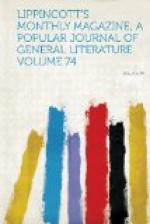chateau, found it safest to make fewer trips and concentrate
their transactions. The great nations, with many
secondary trade-tournaments, as they may be termed,
had each a principal one. From the great fair
of Leipsic, with the intellectual but very bulky commodity
of books for its specialty to-day, we pass to the two
Novgorods—one of them no more than a tradition,
having been annihilated by Peter the Great when, with
the instinct of great rulers for deep water, he located
the new capital of his vast interior empire on the
only available harbor it possessed. Its successor,
known from its numerous namesakes by the designation
of “New,” draws convoys of merchandise
from a vast tributary belt bounded by the Arctic and
North Pacific oceans and the deserts of Khiva.
This traffic exceeds a hundred millions of dollars
annually. The medley of tongues and products
due to the united contributions of Northern Siberia,
China and Turkestan is hardly to be paralleled elsewhere
on the globe. Was, insists the all-conquering
railway as it moves inexorably eastward, and relegates
the New Novgorod, with its modern fairs, to the stranded
condition of the old one, with its traditional expositions.
As, however, the rail must have a terminus somewhere,
if only temporary, the caravans of camels, oxen, horses,
boats and sledges will converge to a movable entrepot
that will assume more and more an inter-Asiatic instead
of an inter-national character. The furs, fossil
ivory, sheepskins and brick tea brought by them after
voyages often reaching a year and eighteen months,
come, strictly enough, under the head of raw products.
Still, it is the best they can bring; which cannot
be said of what Europe offers in exchange—articles
mostly of the class and quality succinctly described
as “Brummagem.” It is obvious that
prizes, diplomas, medals, commissioners and juries
would be thrown away here. The palace of glass
and iron can only loom in the distant future, like
the cloud-castle in Cole’s Voyage of Life.
It may possibly be essayed in a generation or two,
when Ekaterinenborg, built up into a great city by
the copper, iron, gold, and, above all, the lately-opened
coal-mines of the Ural, shall have become the focus
of the Yenisei, Amour, Yang-tse and Indus system of
railways. But here, again, we are overstepping
our century.
[Illustration: Interior view of the transept of crystal palace.]
To us it seems odd that in the days when an autocratic decree could summarily call up “all the world” to be taxed, and when, in prompt obedience to it, the people of all the regions gathered to a thousand cities, the idea of numbering and comparing, side by side, goods, handicrafts, arts, skill, faculties and energies, as well as heads, never occurred to rulers or their counselors. If it did, it was never put in practice. The difficulties to which we have before adverted stood in the way of that combination




